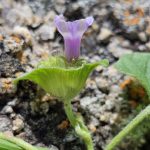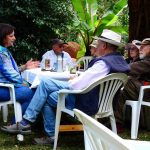TREE LIFE 525
MAY 2024
FUTURE EVENTS
PLANNED EVENTS: MAY
Since inclement weather or other issues may vary our plans, WhatsApp Tony Alegria on 0772 438 697 to join our WhatsApp group for last minute updates.
Saturday 4th May 2024: visit to the National Botanic Gardens. Meet at 8.30 in the main car park and join us for an interesting morning looking at trees that catch our interest.
Sunday 19th May 2024: We will be going to the Arboretum at Lake Chivero for the May third Sunday morning outing. We will share transport from PE School and leave for the Lake Chivero Arboretum at 08:30 so please try and be there early.
TThis replaces the visit planned for January due to the lack of a leader. The Arboretum was planted on Signal Hill in the 1950s and the last Tree Society visit was in September 2022. It is now time to see what changes have taken place. After botanising we eat, drink and socialize so don’t forget your folding chairs and refreshments. If you plan to take your own car, take the Bulawayo Road and the Lake Chivero turnoff is on the left just past the Manyame Bridge. Follow the road as if you were going to the Lake Chivero Game Park. Once over the hill there is a turning to the left at the bottom of the hill – it is signposted. At time of going to press we have no idea what the road will be like.
REPORTS FROM PREVIOUS OUTINGS
NATIONAL BOTANICAL GARDEN OUTING SATURDAY 6th APRIL 2024
By Tony Alegria, photos by Jim Dryburgh
Only seven of us turned up for the monthly tree walk at the National Botanic Garden. On a quiet, sunny day the ladies, Dido de Swardt and Linda Hyde joined up with the men, Jan van Bel, Jim Dryburgh, Karl van Laeren, Mark Hyde and me to look at a Bivinia jalbertii which had recently been discovered (whilst labelling trees) and anything else of interest. Karl wanted to see if the Ficus sansibarica was in fruit, so figs became the target species for the day.
The first fig tree we looked at was the Ficus hippopotami now renamed Ficus trichopoda, which is not indigenous to Zimbabwe but can be seen in Mozambique and South Africa where it’s known as the swamp fig. The interesting thing about this tree is that it has low-lying branches that touch the ground. Where the branches touch the ground, roots grow and the branch coppices at the same place and thus a new tree develops, so the original tree spreads out in all directions.
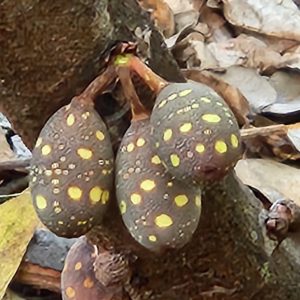
Ficus ottoniifolia subspecies macrosyce (Botanic Garden list no 309)
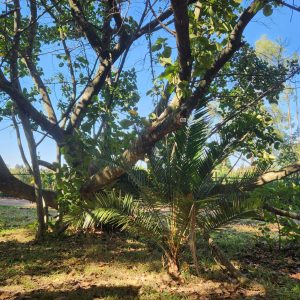
Ficus hippopotami now renamed Ficus trichopoda
We then looked at Ficus dicranostyla, Ficus polita and Ficus vallis-choudae before coming to the highlight of the day – the birds egg fig! Ficus ottoniifolia subspecies macrosyce is more of a climber/bush than a tree and the spotted figs grow on spurs on the branches.
Then we looked at the Usambara fig Ficus usambarensis, with its thick growing tips, clusters of small figs on stalks and very crackly leaves. Very surprising that such a green leaf can sound so much like a dry leaf!
The Ficus bubu had no figs, but these too grow on short spurs. The branches are smooth greenish-yellow and have a powdery bark. The roughness of the Ficus capreifolia leaves have to be felt to be believed!
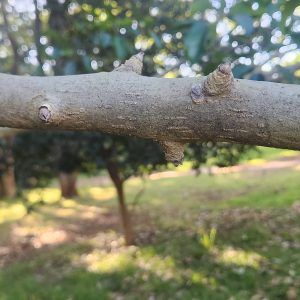
Branch of Ficus bubu showing where the figs grew on the branches.
(Botanic Garden list no 106)
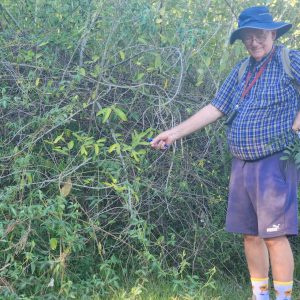
Ficus capreifolia (Botanic Garden list no 205)
We then looked at the Bivinia jalbertii, the Cobweb seed, with loads of fruit, and the nearby Clausena anisata with what I think are stinky leaves, but some of the party found them to be pleasant!
There are a number of fig trees on the eastern side of the Herbarium. The Ficus lyrata appears to have dimpled, sessile figs all year round. The other fig trees, Ficus benghalensis, Ficus elastica, Ficus religiosa and two trees of the Ficus sansibarica had no fruit but the third Ficus sansibarica did.
Apart from the Ficus bubu, Ficus capreifolia, Ficus sansibarica and Ficus vallis-choudae, all the other fig trees are not indigenous to Zimbabwe.
Mark collected some figs and leaves from the ground below a fig tree and later identified it as Ficus fischeri, Poplar-leaved fig, which is also not indigenous to Zimbabwe.
Editor’s notes:
On Sunday 21 April Mark Hyde and I paid a visit to the garden so that I could get a bit of exercise and recap on the figs seen. I was very proud in vaguely remembering and identifying the “Hippopotamus fig” – Ficus trichopoda and the “Birds Egg fig” – Ficus ottoniifolia. I also found Ficus bubu with its yellow bark looking like it belonged on “the banks of the great grey-green, greasy Limpopo River, all set about with Fever trees” and Ficus capreifolia, where we took some close-up pictures of the leaves and discussed what caused the rough rather than furry texture of the leaves. We had fun taking these pictures and making a video of the Ficus usambarensis leaves being crushed (you can hear cheers from the adjacent football field in the background). I thoroughly enjoyed this recap and hope the photos will help those as botanically ignorant as I am to recognize these trees if they take a short walk from the car park along the fence and across the lawn. My thanks to Mark for walking with me.
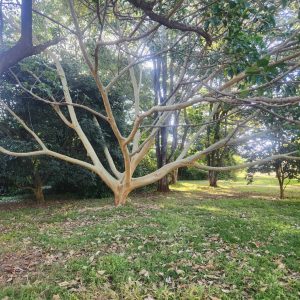
Ficus bubu
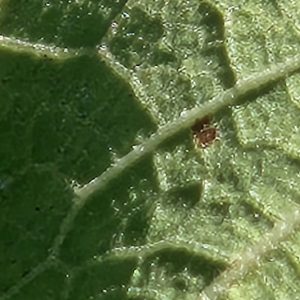
Close-up of the rough surface of the
Ficus capreifolia
MAIN OUTING –
Note: The April outing was replaced by the 74th A.G.M., which is scheduled to be held on Sunday 28th April 2024 at 9.30 a.m.
TRIBUTES TO FRANCES MARGARET “MEG” COATES PALGRAVE
10 MARCH 1935 TO 22 MARCH 2024
MEG’S STORY FROM MARK HYDE
“A mighty tree has fallen” – African proverb.
Frances Margaret “Meg” Coates Palgrave (née Stead) was born in Bulawayo on 10 March 1935.
Her father was employed in what was then called the Native Department, until he moved to London Farm near Juliasdale. Meg was 15 at that time so she spent her childhood when not at boarding school in a rural environment.
She was educated in Umtali, now Mutare. The picture below shows the Umtali High School prefects in 1952. Meg is in the back row on the far left. Next to her, on her left is Tony Ade, another former member of the Tree Society.
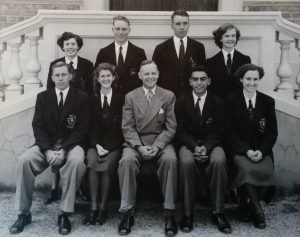
Umtali High School prefects 1952
After school, she started studying botany, amongst other subjects, at Rhodes University in 1953, but had to give that up due to family money pressure. She was also a keen hockey player and was selected for Rhodesia as goalie.
Meg married Paul Coates Palgrave in 1957 on London Farm and thus began a 25-year partnership of study, research and frequent camping trips to wild places in Zimbabwe.
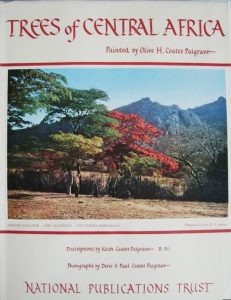
TREES OF CENTRAL AFRICA
Trees of Central Africa
In marrying Paul, Meg had married into the remarkable Coates Palgrave family who had already in 1956 published a book on trees, namely Trees of Central Africa.
Paul’s mother, Olive was a talented artist and although she was not a botanist in the formal sense, she produced the beautiful and accurate paintings of leaves, fruits and flowers, which were used to illustrate the work. The text was written by Keith Coates Palgrave and photographs by Paul and Deric. It covered approximately 110 species.
Meg donated the original illustrations to the Royal Botanical Gardens, Kew, as they are an early scientifically correct illustration of those trees.
The Umtali years c. 1958-1971
Paul worked in Salisbury for 15 months after his marriage and then applied for a post in Umtali. Accommodation was at that time desperately short in Umtali, and they stayed initially in the old Toronto Mine house, near the Penhalonga road. During their time in Umtali, the two children, Shirley and Tony were born, in 1960 and 1962 respectively.
It was there that Meg and Paul were introduced to the fascination of bird watching by an elderly neighbour, who lent them a copy of Roberts’. In addition, they became keen members of the Museum Society. The stage was set for a new photographic subject and in no time, Paul was inventing devices to make bird photography possible on a shoestring. Meg recalls the setting up of a birdbath and the agonies of trying to induce birds to land on a particular twig so that the camera, concealed in the bushes and set off from a distance, would capture the subject.
Later they moved to a house close to town set on half an acre. Meg recalls their excitement at finding Fagaropsis angolensis in the garden. Thus began 12 busy years for Paul and Meg, both at work and at home. Paul was always on call and made trips at weekends to the lab to check cultures and do emergency tests. However, the lab was close enough to the house for him to rush home at lunchtime and after work to pursue his many interests.
Meg and Paul were interested in natural history of all types (Meg’s specialisation on trees was to come later) and they entered a world of different projects.
- They hunted for semi-precious stones in the lowveld, which involved traipsing through dry riverbeds and in the bush, then preparing the stones in a tumbler made by Paul. They were most successful at producing jewellery and other ornaments.
- They were always interested in photography and converted one of the bedrooms into a dark room with an enlarger to print photographs; they entered many competitions to test their skills, winning numerous prizes.
- Meg was particularly interested in tortoise beetles and loved her Barberton daisies.
- They produced a film called Pattern of Life, which was based on the circle of life – predominantly of butterflies, which took up a huge amount of time and effort.
The house became a vast container for endless jars of munching caterpillars. After numerous disasters and modifications of techniques and equipment, the film was at last run off on 8 mm film, but later entirely re-filmed on 16 mm. During this time Paul would sometimes wait at work like an expectant father for the emergency call from home to tell him that the butterfly egg Meg had been watching for days was about to hatch. Then would follow a frantic rush to capture on film the priceless moment of emergence of a minute caterpillar whose life history would complete itself in a jar on the dining room table.
While tidying up Meg’s stuff her son Tony came across a letter from MGM saying that unfortunately the film was 40 minutes long and their analysis of people’s attention span was 30 minutes, so they weren’t able to broadcast it!
- Both Meg and Paul were involved in doing the photographs for the Bundu book series on Snakes and of course the one on Trees. All the snake photographs were taken of live specimens, except the Black mamba. The snakes were cooled down in the fridge and then positioned correctly on the dining room table. One evening when they were taking the green mamba (live), there was a power failure, and all went dark. The first thing was to get the children and the dog out onto the veranda and then to find some light. Fortunately, the snake was still on the table and disaster was averted.
1971-1976 Salisbury and work on “The Book”
After the move to Salisbury, work began on “The Book”, namely Trees of Southern Africa.
Paul and Meg worked long hours laying out and photographing leaves and travelled widely, photographing fruit, leaves and flowers for the colour plates.
It was an exciting and exhausting time, and would no doubt make a story in itself. Paul and Meg did much of the research as to the common names, and Paul and his daughter and son drew most of the leaves. The text was written by Keith with botanical advice from Bob Drummond and Meg and Paul helped with checking the text and proofs and produced the list of English names. The work was finally published by Struik in 1977.
In my view, it is remarkable that the principal work on Southern African trees was written in Rhodesia as opposed to South Africa.
Later life
The work on Trees of Southern Africa led to trees becoming Meg’s main interest.
Work on other books continued with the publication of Everyone’s Guide to Trees of South Africa by Keith, Paul and Meg, which was published in 1985 shortly after Paul’s death on 6 June 1983.
In 1989 Meg published the booklet A Guide to the Trees of the Mukuvisi Woodlands, which used a successful technique of illustration using photocopied leaves, and then in 1996 she published Key to the Trees of Zimbabwe comprising keys for six different areas. This book was enthusiastically received, and Meg was presented with the Bob Rutherford Memorial Award in 1996 in recognition of her substantial contribution to conservation.
In Harare, Meg worked in the accounts team for an insurance company Etna, and then Stewart Scott and partners, a structural engineering company in Harare. This didn’t satisfy her love for the natural world, and she wanted to combine both her working life and free time concentrating on this so in around the mid-90s, she left her job and retrained as a safari guide. Parts of the training were intended to demonstrate that she could defend herself and any visitors while out on safari and to do this, she had to shoot an elephant and a buffalo. Meg resisted this as it didn’t sit comfortably with her conservation values.
This was followed by a spell on a farm in Raffingora, where she catalogued and identified their trees and set up a conservation area.
In 2004 Meg sold her house in Kariba Cresent for a whopping ZWL 12bn and moved to Blue Kerry. She always remarked that this was the best move she had ever made and the support and friends she made there were wonderful and were the reason she didn’t want to move to South Africa or the UK (apart from there being only six indigenous trees in the UK).
Other publications
In 2004 Jacana published the Sappi Tree Spotting Lifer List attempting to standardise English common names for trees in South Africa with Meg as one of the eight co-authors. Meg says that was great fun as we all got together several times and discussed the pros and cons of all the names which effectively meant discussing trees.
1st September 2011, Arbor Day in South Africa saw the launch of the Dictionary of Southern African Trees in the Botanical Garden in Pretoria for which Meg was a co-author with Braam van Wyk, Erika van den Berg and Marie Jordaan. This dictionary is a catalogue of the names of some 2,100 species of trees, shrubs and woody climbers providing both the scientific names and over 24,000 common names in 30 languages.
Due to her expertise and reputation, she was asked to join a number of EU and WHO studies that looked at the impact of various man-made interventions. One that her son remembers was an area downstream of Kariba Dam where a study was taking place to investigate the impact to the flora and fauna of there being no seasonal flooding since the dam wall had been built.
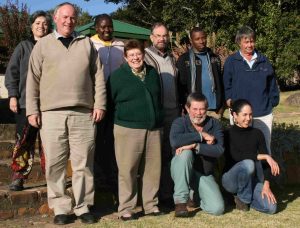
Meg at a Red data conference in SA 2014
Always keen to share her knowledge and engage with more people, Meg collaborated with an app developer to help with the identification of trees in a modern platform. This app was available on both iPhone and Android and was based on the ‘Know your Tree’ booklets, but supplemented with photographs. As always, Meg believed that the start of identifying a tree was a leaf because “we’re not always as lucky to have a flower or fruit”.
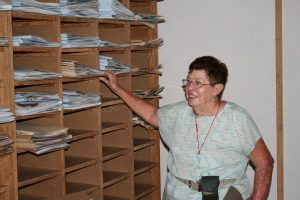
Meg in the Catapu Herbairum, 2012
Mozambique and the Catapú Herbarium
Another big achievement was the creation of the herbarium at Catapú in Sofala Province in Mozambique. With the help of Ant White, a purpose-made herbarium was built to house the numerous specimens. A whole new world of tree species opened up for her. Meg would make the drive from Harare to Catapú, sometimes on her own, until well into her 70s and possibly 80s. “If my family knew what I was doing, they would be horrified” she confided to me once. The Catapú herbarium has recently found a new safe home at the EO Wilson Herbarium in Gorongosa.
Awards
In addition to the Bob Rutherford Award, Meg was awarded the Marloth Medal by the Botanical Society of South Africa. This medal is awarded to any amateur or professional botanist who has produced scientific literature of a popular nature to stimulate public interest in the indigenous flora of southern Africa. The announcement was made by Ted Oliver at the final plenary session of the AETFAT (The Association for the Taxonomic Study of the Flora of Tropical Africa) congress in Stellenbosch in January 2014.
Tree Society of Zimbabwe (personal recollections from Mark Hyde)
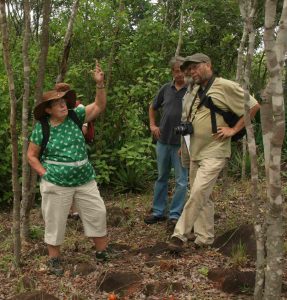
Meg making a point on an outing in 2010
I first met Meg on a Tree Society outing in 1988 and therefore have known Meg for 36 of her 89 years.
The Tree Society was important to Meg. She was Chairman from 1981 to 1983 and apart from the times when she was not resident in Harare always liked to attend the outings, often acting as leader.
Two phrases were particularly associated with Meg. One that we know so well is ‘Pick a leaf’. This is so that you can learn about the trees by their feel, their smell, their taste, their hairiness, whether they have pellucid glands, whether they are 3-veined from the base or whether they have special characters like dendritic hairs. ‘Picking a leaf’ is one way to really get to know your trees.
A second phrase of Meg’s was: “all trees have labels”. People need to learn to read those labels and that is not always easy as we well know.
Meg loved teaching people about trees. She always emphasised the importance of looking carefully; she liked active hands-on participation.
She applied the same approach to her tree courses. Meg liked to prepare thoroughly, usually creating a tailor-made small booklet containing keys to the species of the area. This is one of the reasons why she knew her trees so well; there’s nothing more demanding than constructing keys that work. Trees vary, they have foibles, they don’t always stick to the rules and follow what is in the books.
Meg’s interest was more or less confined to indigenous trees. Woe betide any leader of a Tree society outing that started looking at exotic trees or herbaceous plants, but in recent years her attitude to these softened and she became mildly interested in them.
She had her foibles as well
She was sceptical about the existence of hybrids; anyone struggling to separate species A from species B who said, “perhaps it’s a hybrid?” would receive very short shrift from Meg. To her, this was a sign of an inability to make up your mind.
She also was not very interested in taxa lower than species level, namely subspecies and varieties. These are sometimes distinguished based on the presence or absence of pubescence; Meg would say it was “just splitting hairs”.
She was very sceptical of “herbarium botanists’ who did not know the trees in the field.
Meg was active right up to the end. She and I visited the National Herbarium on a weekly basis for the past year and worked on identifying specimens. Her eyesight was failing but her mind was still sharp – she would ask about a specimen – “does it have hairs?”, “milky latex? and I would act as her eyes.
Together we would cover a lot of ground. Meg enjoyed those days very much – as did I.
The Memorial service
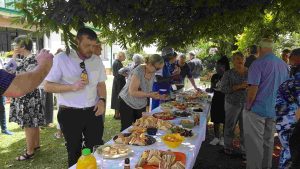
Meg’s memorial lunch
About 100 or so people from all aspects of her life gathered on the lawn on 30 March 2024 at Blue Kerry to celebrate Meg’s life and work. The large number is a testimony to how well known she was in Zimbabwe.
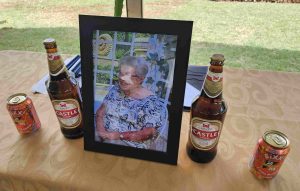
The memorial table
Meg loved her beer, Castle in particular. The picture shows the highly appropriate table at her memorial service.
Conclusion
Meg was greatly admired and loved by all who knew her, and she has left a ‘Meg’ sized hole in many hearts. Her friends, children, grandchildren and great grandchildren will miss her dearly.
As an appropriate resting place it was decided to bury Meg’s remains in the Mukuvisi Woodland and a tree species of particular interest to her, the Wild camphor, Tarchonanthus camphoratus was chosen. I feel honoured and privileged that I was asked by the family to lead them to the tree in question and be present at this small informal farewell gathering.
Acknowledgements
Most of the details of Meg’s early life came from the family’s eulogy, written by Tony and Shirley, and the article by Cheryl Haxen (see references) and I have extensively quoted from these.
References and sources
Coates Palgrave family (2024). Eulogy presented by Tony Palgrave at Meg’s memorial on 30 March 2024.
Coates Palgrave, FM. Online biography downloaded from https://www.zimbabweflora.co.zw/speciesdata/person-display.php?person_id=14 on Sunday, 21 April 2024. This was written by Meg herself a few years ago.
Coates Palgrave, K et al. (1956). Trees of Central Africa. National Publications Trust, Salisbury.
Coates Palgrave, K (revised and updated by Meg Coates Palgrave) (2002). Trees of Southern Africa. 3rd edition. Struik, South Africa.
Haxen, C (1983). Paul Coates Palgrave – some memories. Tree Life 41. Online at https://treesociety.org.zw/tree-life/41/.
FROM FAY ROBERTSON:
Botanists and naturalists in southern Africa owe Meg an enormous debt for her work on Trees of Southern Africa. She also set an admirable example of adaptability; a qualified teacher, specialist guide, leader of tree identification courses, indigenous gardener, author and advocate, Meg gave good ecological reasons for encouraging the regrowth of indigenous woodland from suckers and coppice, rather than by planting seedlings. She was always ready to share her plant knowledge, especially in the field where, even towards the end of her life, Meg did not let her walker get in the way of an interesting plant.
FROM MARY TOET WHO REMEMBERS THE EARLY DAYS:
Meg, I wish you were here. If you remember those early morning walks in the Mukuvisi Woodlands in the early 70s. We would nearly step on something you would call a suffrutex (there were 7 suffrutex species in the Woodlands).
We often discussed what made those suffrutex so resilient. You could step on them, stand on them, hit against them with your foot. They did not appear to be chewed or browsed. Meg was not restrained and had a brilliant inquiring mind. She was a Botanist and enjoyed the ecological riddle of the suffrutex. She would say, “A lot goes on underground, you know”.
Meg’s definition of a tree was that if you could sit under it and it gave you shade it was a tree. Taxonomy is what she enjoyed the most and in her later years spent time in the herbarium. She had an in-depth knowledge of morphology. She would pick out the key differences between trees in the area under study and devise a key. Her neat orderly mind produced a good key that was easy to follow without confusion.
I think one of her first keys was for a course on trees that she gave on the Raffingora area. The course lasted three days and was attended by the wives of farmers in the area. I attended this and was amazed by Meg’s patience and teaching skills. Meg reacted to people with sincerity and she was empathetic. She enjoyed imparting knowledge on her beloved subject, Trees.
On one early morning walk Meg asked me what a fundi was. I told her a fundi was an expert. Meg proved later to be a Global fundi on her favourite topic and that was Trees.
People who encountered Meg enjoyed her friendliness and humility. One person was Dr Harcombe who asked specifically to be mentioned in her eulogy.
Meg, I treasure those memories of our early morning walks in the Mukuvisi Woodlands.
Rest in peace.
OTHER NEWS
We heard recently of the death of Claire Cullinan, a former member of the Society. Our sincere condolences go to her husband Mike.
SHORT NOTES
UNUSUAL FUNGUS ON A BUFFALO THORN IN THE BALLANTYNE PARK AREA :
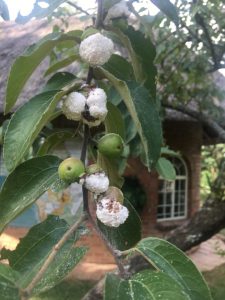
The fungus Coniodictyum chevalieri
The following article on the fungus is by Don Lapham. The article he refers to which is of interest is at https://www.ncbi.nlm.nih.gov/pmc/articles/PMC2104722/ .
Hundreds of these “white balls” have been developing on a Buffalo Thorn (Ziziphus mucronata) tree in the Ballantyne Park area during the last couple of months. The fungus (Coniodictyum chevalieri) attaches itself to the immature fruit and sheds a white powdery cloud if knocked. The balls may become as large as a golf ball but do not seem to harm the tree. Eventually, they drop and have a hard, woody interior, which is difficult to cut, and a white powdery covering.
I guess that the Purple-crested Turacos will be upset that there will be little mature fruit this year.
An outbreak of the disease was noticed in the Kruger National Park in 2004. It was studied and written up (the reference to this paper is above).
TREE SOCIETY COMMITTEE AND CONTACTS
Chairman Tony Alegria tonyalegria47@gmail.com 0772 438 697
Honorary Treasurer Bill Clarke wrc@mweb.co.zw 0772 252 720
Projects Jan van Bel jan_vanbel@yahoo.com 0772 440 287
Venue Organiser Ann Sinclair jimandannsincs@zol.co.zw 0772 433 125
Committee Member Ryan Truscott ryan.kerr.truscott@gmail.co 0772 354 144
Secretary Teig Howson teig.howson@gmail.com 0772 256 364
Tree Life Editor Linda Hyde Lmharwin@pentact.co.zw 0772 232 075
Tree Society Website https://treesociety.org.zw/
Tree Society Facebook https://www.facebook.com/groups/ztreesociety/
Flora of Zimbabwe: https://www.zimbabweflora.co.zw/
Flora of Tropical Africa: https://plants.jstor.org/collection/FLOTA


